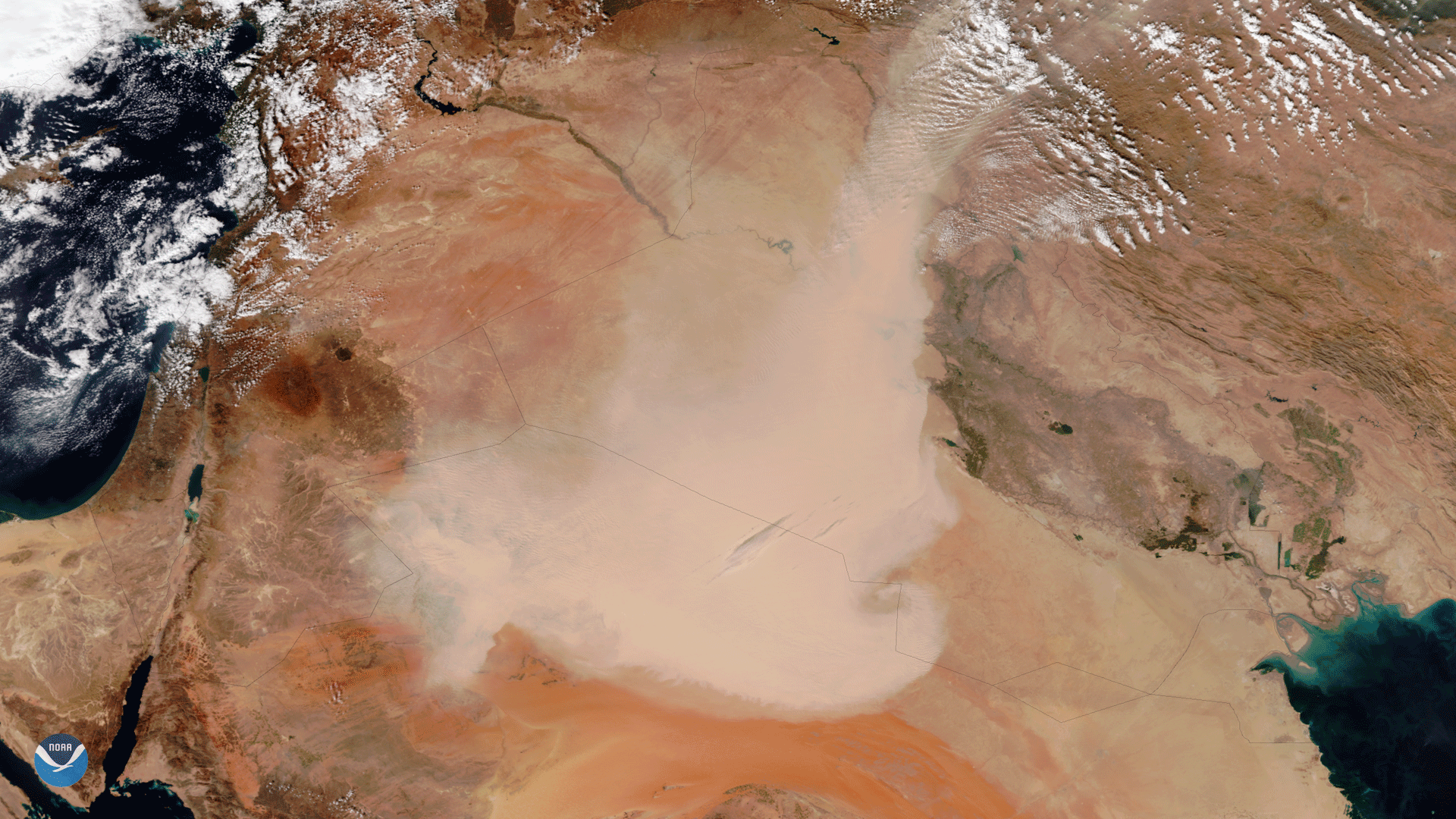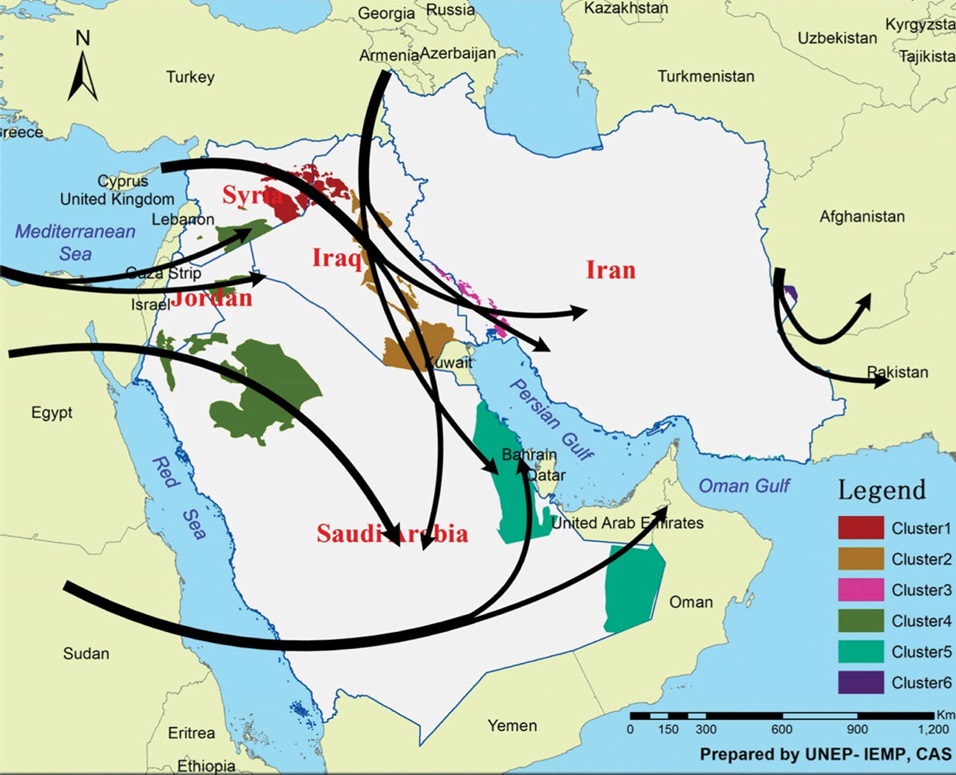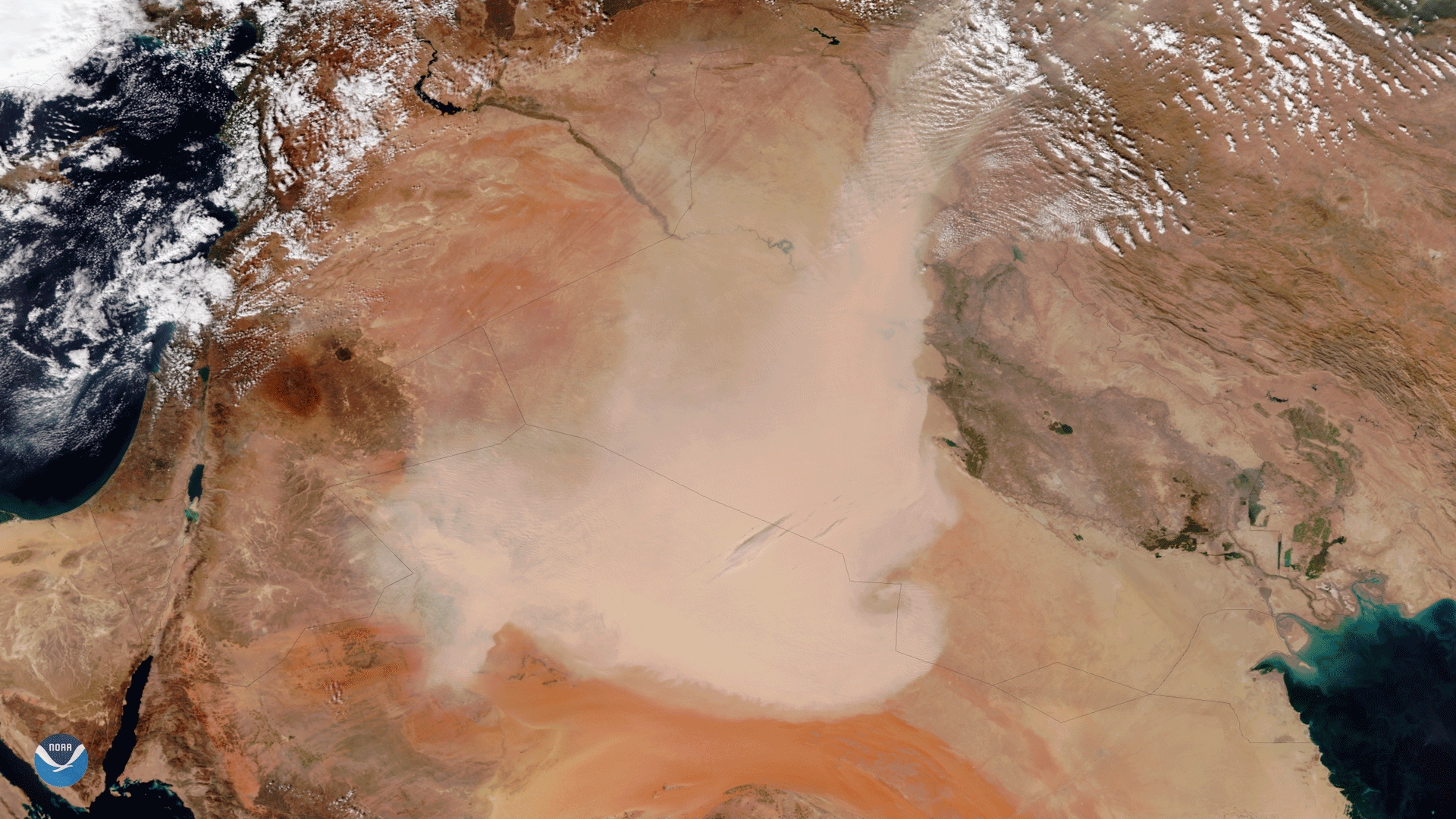Greening agriculture, water scarcity and climate action
Combating sand and dust storms in MENA: the role of tree plantation

A massive sandstorm over Saudi Arabia and Iraq on 29 October 2017
©nesdis.noaa.gov
As we celebrate the International Day of Combating Sand and Dust Storms 2024, it is crucial to delve deeper into the complexities of this issue. Sand and dust storms (SDS) are natural phenomena driven by a combination of environmental and human-induced factors. Land use changes, such as deforestation, overgrazing, and unsustainable agricultural practices, strip the land of its protective vegetation, leaving soil vulnerable to wind erosion. Climate variability and change exacerbate the situation, with prolonged droughts and shifting weather patterns intensifying the frequency and severity of these storms. In arid and semi-arid regions, where dry, loose soils are abundant, strong winds easily lift and transport vast amounts of dust and sand across large distances, impacting the environment, climate, and human health. The convergence of these factors creates a perfect storm, unleashing clouds of particles that cross borders and continents, posing significant threats to sustainable development and agriculture.
Due to its proximity to the Sahara Desert, the Middle East and North Africa (MENA) region is one of the dustiest in the world. While natural sources like the Sahara are the primary contributors to dust storms in MENA, land-use changes and human-induced climate change have introduced additional anthropogenic sources. It has been estimated that 75 percent of global dust emissions come from mostly desert drylands, and can be considered as natural, whereas the remaining 25 percent are anthropogenic

Paths and point sources of SDSs in MENA
Source: Cao et al., 2015.
The costs of sand and dust storms in MENA
Sand and dust storms are not merely transient weather events but complex phenomena with far-reaching consequences. Each year, SDS events cause substantial economic losses and environmental degradation across the MENA region. The economic impact alone is staggering, with losses in GDP amounting to billions of dollars annually due to damage to infrastructure, agriculture, and health-related costs from air pollution. Globally, dust causes welfare losses amounting to approximately $3.6 trillion, with costs in the MENA region alone averaging around $150 billion and exceeding 2.5 percent of GDP.
Challenges and opportunities
Despite progress, challenges in SDS management persist. Sand and dust storms degrade air quality, increase respiratory illnesses, and exacerbate existing health conditions. Airborne particulate matter during SDS events spikes to hazardous levels, posing severe risks to public health and straining healthcare systems. Moreover, SDS events devastate agricultural productivity by stripping fertile topsoil, which is essential for crop growth. Countries struggle to maintain agricultural sustainability amid recurring dust storms that diminish soil fertility and water retention capacity, further aggravating food insecurity and rural livelihood challenges.
Vegetation cover is a major factor of wind erosion. Vegetation degradation due to grazing, wildfires, deforestation and other human activities, and to climate change has been identified as main cause of LD and SDS, particularly in drylands characterized by extensive rangeland systems.
Limited capacity for early warning systems remains a critical issue, leaving communities vulnerable to sudden SDS events. Strengthening meteorological monitoring and forecasting capabilities is essential to providing timely alerts and mitigating socio-economic impacts. International cooperation is crucial for developing regional strategies to address SDS, given the transboundary nature of these storms. Collaborative initiatives, such as the United Nations Coalition on Combatting SDS, facilitate knowledge exchange and capacity building among affected countries in the MENA region.

Dust Extends from Saudi Arabia to Iran. 4 March 2010.
© NASA image courtesy MODIS Rapid Response Team at NASA/Goddard Space Flight Center
FAO's role in SDS mitigation
FAO has been at the forefront of efforts to mitigate SDS impacts through innovative agricultural practices and policy support. In 2020, FAO launched the project "Catalysing Investments and Actions to Enhance Resilience Against Sand and Dust Storms in Agriculture" to address the escalating threat of sand and dust storms on agriculture. By collaborating with key partners such as the Centre for Policy Research (CPR), International Center for Agricultural Research in the Dry Areas (ICARDA), and national ministries from affected countries, FAO aimed to enhance the resilience of agriculture-dependent communities. The project focused on developing and sharing knowledge on SDS sources, impacts, and sustainable land use practices. This initiative successfully conducted technical support and training for government staff and vulnerable farmers, raising awareness and strengthening their capacity to combat SDS. Notably, FAO managed to integrate SDS considerations into national disaster risk management policies and practices, conducting risk and vulnerability assessments and developing SDS contingency planning and Standard Operating Procedures (SOPs) for agriculture in pilot districts of three partner countries.
Concrete results from the project include the creation of a comprehensive searchable Excel database with over 150 adaptable good practices to mitigate SDS effects, accessible online to cater to various contexts. The project also produced policy briefs that serve as the foundation for risk-informed policies and strategies at different levels, ensuring sustainability. FAO's efforts in environmental sustainability were evidenced by the increased awareness of SDS impacts and the introduction of agricultural solutions to mitigate these effects. Additionally, the project laid the groundwork for a large-scale programme addressing SDS in agriculture, ready for country-level commitments and resource mobilization, thus significantly contributing to SDGs related to life on land, poverty eradication, food security, sustainable cities, and climate action.
FAO’s leveraging of tree plantation initiatives to mitigate sand and dust storms
Mitigating the impacts of SDS is crucial for the sustainability of agriculture and the protection of vulnerable ecosystems in the MENA and NENA regions. Integrating tree plantation programmes, such as those focused on reforestation and afforestation, offers a viable solution to reduce SDS impacts by enhancing land cover and stabilizing soil.
In Algeria, a FAO-led project targets the rehabilitation and sustainable management of cork oak forests (COFs), addressing degradation from fires, unsustainable harvesting, and agricultural encroachment. This GEF-cofinanced initiative covers 22 530 ha across three pilot sites. It focuses on developing sustainable harvesting plans with local communities and strengthening value chains for cork and non-timber forest products (NTFPs). The project aims to create a supportive economic environment through traceability systems and certification frameworks, with plans to upscale successful practices nationally.
In Lebanon, the "Smart Adaptation of Forest Landscapes in Mountain Areas" (SALMA) project, launched in 2016 with $7.1 million from the GEF, focuses on reforestation and sustainable management of threatened forest ecosystems. The project reforested 674 ha across 23 sites and developed management plans for 1 230 ha. Emphasizing community involvement, the project engaged local municipalities and NGOs in tailored reforestation plans, alongside fire prevention measures and integrated pest management, enhancing the resilience of rural mountain communities.
In Sudan and Mauritania, FAO supports the Great Green Wall Initiative (GGWI) with projects aimed at restoring degraded lands and enhancing adaptive capacity. In Sudan, the "Gums for Adaptation and Mitigation" project, funded at $9.9 million, focuses on restoring gum agroforestry systems and reforesting 50 000 ha.

© tehrantimes
Integrated risk assessment and early warning systems
One of the fundamental steps in mitigating SDS impacts is the integration of SDS hazards into multihazard risk assessments. These assessments systematically evaluate the nature, intensity, frequency, and probability of SDS events, considering the region’s unique physical, socioeconomic, and environmental dimensions. By identifying vulnerable areas and populations, countries can prioritize resources and interventions effectively.
Establishing robust data and information systems for disaster risk management (DRM) is crucial. These systems facilitate the development of multirisk and vulnerability profiles, sector-specific maps, and early warning systems tailored to agricultural communities.
The path forward: Integrating SDS mitigation into sustainable development goals
Moving forward, integrating SDS mitigation strategies into broader sustainable development agendas is imperative. Implementing sustainable land management (SLM) practices is instrumental in building resilience against SDS. Practices such as conservation agriculture, wind erosion control, and agroforestry not only improve soil health and water retention but also reduce the susceptibility of agricultural lands to wind erosion during SDS events.
Policies promoting ecosystem restoration, sustainable land management, and climate resilience are essential for reducing vulnerability to SDS impacts and promoting environmental sustainability. Investments in research and innovation are needed to develop cost-effective technologies and solutions tailored to the specific challenges faced by MENA and NENA countries. This includes expanding regional cooperation frameworks and strengthening institutional capacities to manage SDS effectively.
Read more about sand and dust storms
- Impacts of Sand and Dust Storms on Oceans: A Scientific Environmental Assessment for Policy Makers
- Sand and dust storms compendium: Information and guidance on assessing and addressing the risks | UNCCD
- UN Coalition to Combat Sand and Dust Storms
- Sand and dust storms (SDS): A transboundary issue of growing concern
- Sand and dust storms. A guide to mitigation, adaptation, policy and risk management measures in agriculture
- Contingency planning process for catalysing investments and actions to enhance resilience against sand and dust storms in agriculture in the Islamic Republic of Iran
 | Senior Programme Officer FAO Regional Office for Near East and North Africa |
